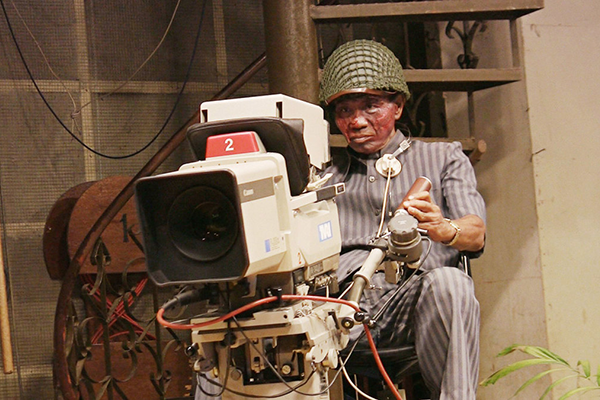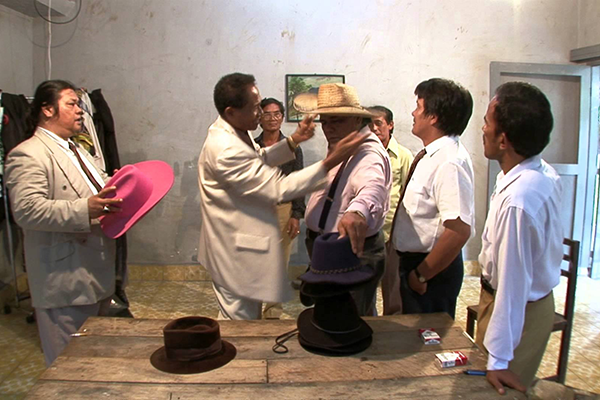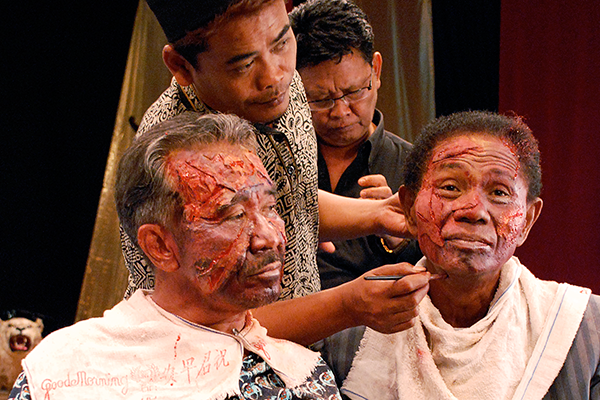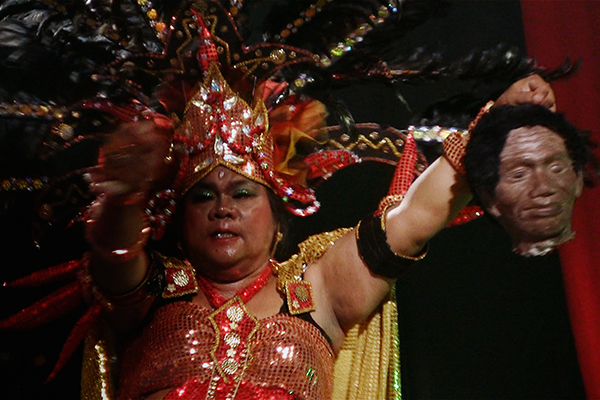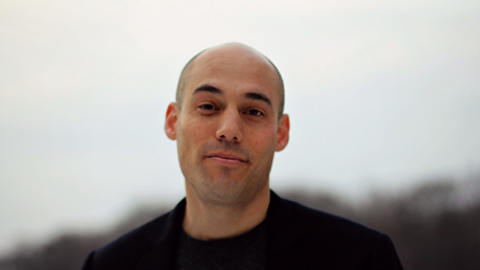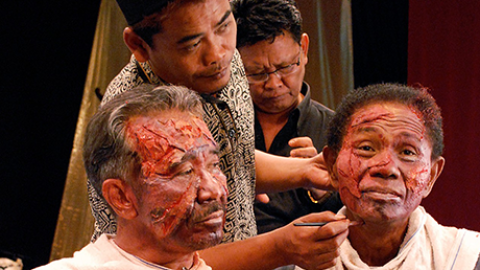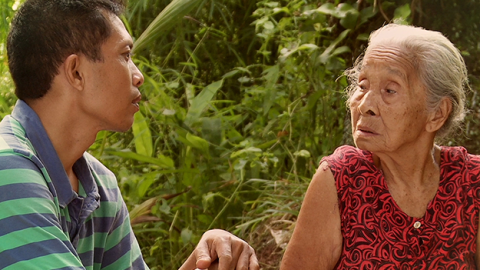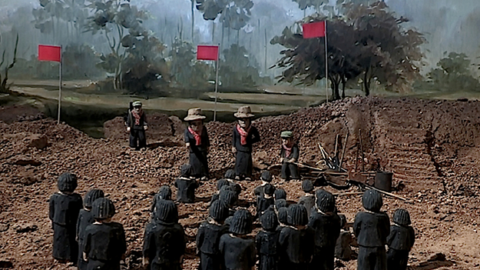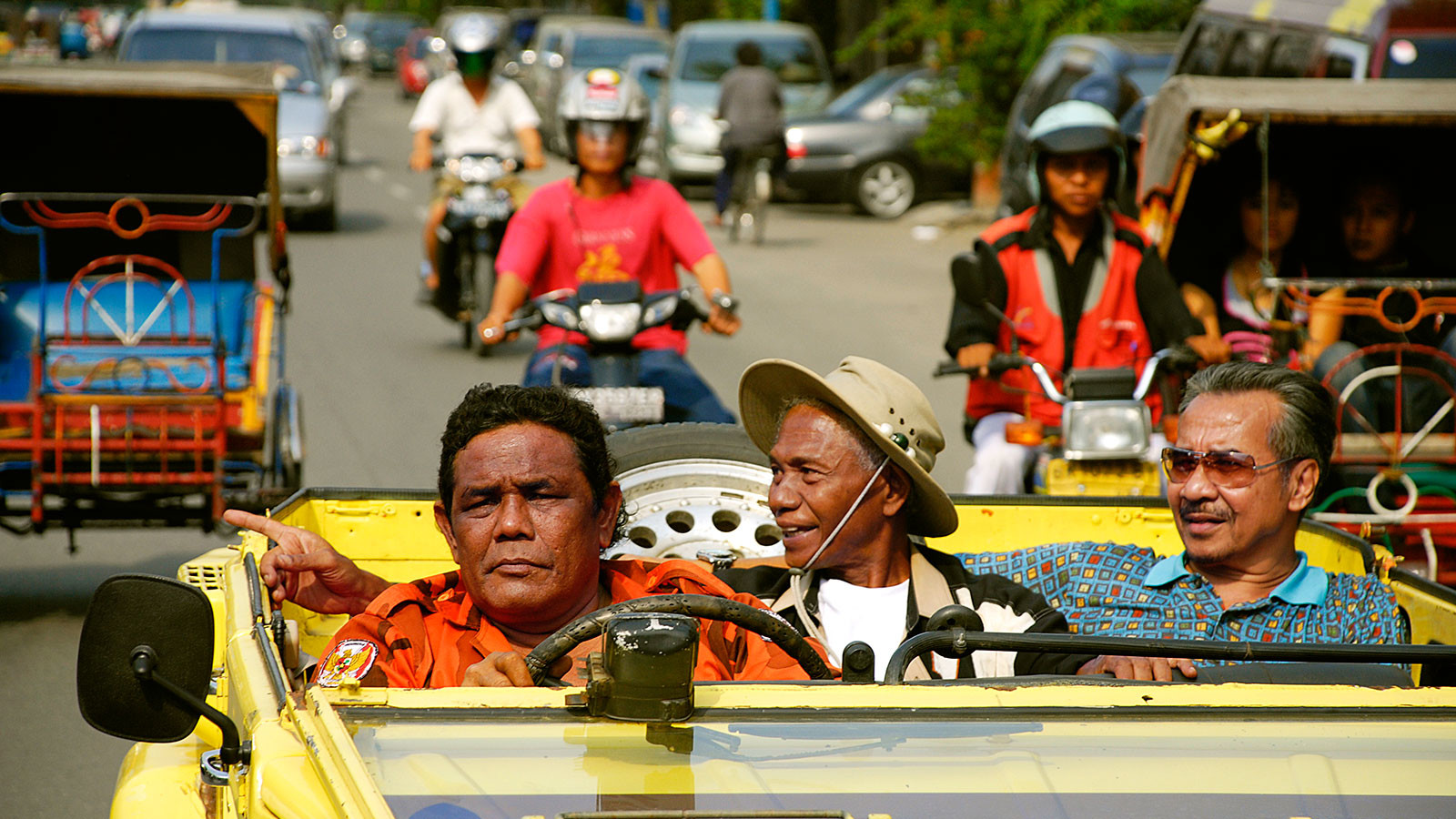
The Executioner’s Song
After a government-conducted massacre has become sufficiently pervasive—when the number of murdered civilians rises above, say, a million—what sort of documentary can be adequate to the crime? In The Act of Killing, which stirred excitement at festivals from Telluride in 2012 through New Directors/ New Films this past spring, Joshua Oppenheimer gives a startlingly unconventional answer to this question, suited especially to the Indonesian genocide of 1965-66 and its bizarre aftermath.
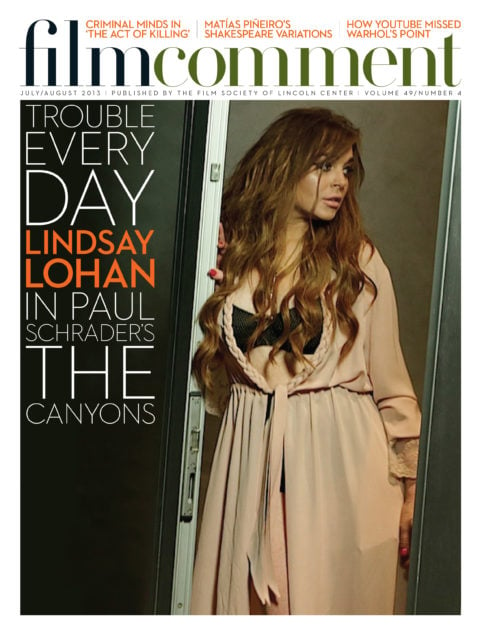
All mass slaughters are bizarre, of course, and permit no decent generalization. Still, a standard exists in many people’s minds, set by the Nazis’ murder of the European Jews, with the result that documentaries about the Holocaust have come to seem normative. This is perhaps one reason why Oppenheimer’s film feels so strange and disturbing. It diverges from accepted models for depicting genocide.
There are principally two of these, the first of which might be called the forensic brief. It assembles archival footage, written records, and eyewitness testimonies with the goal of presenting the verified facts in a chronological progression. Immediately after World War II, the U.S. Army’s Office of Strategic Services made two pure specimens of this type of documentary—The Nazi Plan and Nazi Concentration Camps—which prosecutors screened as evidence at the first Nuremberg trial.
The second prevalent type of Holocaust documentary, the moral travelogue, is perhaps best known to audiences through Claude Lanzmann’s Shoah (if a cinematic terrain of many bumps, mounds, and hillocks can be said to be known by Everest). Knowing that all responsible people agree on the historical record, Lanzmann saw no need to present another chronological account—let alone prove that the Holocaust had taken place—but instead explored the traces left in the landscape and in memory by the slaughter of the Jews.
When Oppenheimer set out to document the mass political murders in Indonesia in 1965-66 and their lingering effect on daily life in that country, he apparently felt that neither of these ready-made categories would serve. A forensic documentary would have been superfluous, since the murderers did not hide their crimes half a century ago and do not deny them today. (According to the killers, the victims had it coming because they were Communists—a term used to describe actual or suspected Party members—insufficiently anti-Communist, or Chinese.) Nor did it make sense for Oppenheimer to undertake a moral journey. After three years in Indonesia—he arrived in 2001-02 to produce The Globalization Tapes—he realized that he was in a country where right and wrong have been reversed. The Nazis, or their equivalents, were not defeated there, and despite the ousting of Suharto in 1998, remain a powerful force in the country—in the government, in the ranks of the millions-strong paramilitary, and on streets dominated by the gangsters who used to run death squads.
Two of these gangsters—the elderly Anwar Congo and his younger henchman, Herman Koto—were glad to cooperate when Oppenheimer proposed filming them. They were even willing to re-enact their crimes for the camera. By way of contrast, think of Franz Suchomel, the former SS officer captured by a hidden camera in Shoah. He, too, liked to show off; recall his pride as he performed a jaunty marching song that the Nazis forced their victims to sing on the way to death in Treblinka. Now imagine a society in which clandestine recording would be unnecessary, a society that would encourage a Suchomel as he paraded his self-satisfaction on the streets and entertained the public with tales of his murderous exploits. This is what you see early on in The Act of Killing as Koto and Congo, amid laughter and applause, recruit residents of a slum neighborhood to act as villagers begging for their lives. This moral incongruity moved Oppenheimer to create a new category, a documentary of the genocidal imaginary, in an attempt to record not the crimes of the past but the inner world of the criminals.
Despite appearances, he has not departed entirely from tradition. Shoah, too, albeit with a different purpose, has its element of performance, used in one of the film’s most devastating segments with a witness named Abraham Bomba. He had survived Treblinka as a member of a work detail, shearing the heads of women on their way to the gas chambers. To draw out Bomba’s memories and emotions, Lanzmann inserted the retired barber into a Tel Aviv barber shop, gave him a pair of scissors and a customer to work on, and prompted: “Show us how you cut the hair.”
Oppenheimer, for his part, must have said, “Show us how you killed people,” because in one of his first scenes the spare-framed, wiry-haired Congo does just that. On a rooftop in the city of Medan, he remembers that the place used to stink when he beat purported Communists to death. “Too much blood,” he complains. With the help of a shyly smiling assistant, Congo then demonstrates the cleaner, more efficient method he developed of garroting the victims with a wire loop.
Abraham Bomba broke down in the middle of his performance. What emotions does the reenactment call up in Congo? None, apparently. Although Congo talks about his need to get his mind off the murders, he speaks so avidly about his preferred remedies—booze, marijuana, Ecstasy, and dance halls—that you’re left with the impression of a man savoring his pleasures. Still lithe in his seventies, Congo concludes the scene by performing a smooth cha-cha across his former killing floor. “He’s a happy man,” says the assistant.
At this stage, nothing seems to disturb Congo except his on-screen infelicities, potential and actual. Having started out as a so-called movie gangster, who made a living scalping tickets at theaters in Medan, Congo knows his MGM, his Paramount, his Rank Organisation, and is sensitive to film aesthetics. He seems to crumple in his chair when the rooftop footage is replayed for him on his home TV. He shouldn’t have looked back at the camera, he says. He shouldn’t have smiled—this is a serious scene. And isn’t it wrong, in this reconstruction of history, that his hair is white? He thinks he should dye it.
With that, The Act of Killing depart from a realistic use of performance and enters a mode of parody, travesty, and delirium. Congo and Koto accept Oppenheimer’s invitation to reenact their crimes as they would like to envision them: as scenes from the American movies they love. The two gangsters and others in their circle begin to appear in the costumes and mise en scène of films noirs, Westerns, horror movies, even musicals. Sometimes Oppenheimer shows you the preliminary sessions with the costumer and makeup artist, to prepare you for these micro-movies. Often, when you’re in the midst of one of these scenes concocted by the killers, Oppenheimer will shatter the frame by cutting away to the film crew. He consistently helps to create illusions only to debunk them.
And still you become disoriented. The Act of Killing does not unfold as I’ve been describing it in my reasonable, unfaithful summary but rather throws you into the fantasies first and explains them later—and none too thoroughly at that. It begins not with a matter-of-fact introduction of Congo and Koto but with visions that seem to have emanated from the mind of a not-yet-identified dreamer: a dilapidated concrete building in the shape of a goldfish, from the mouth of which emerges a line of dancing girls; a view of a lush landscape with a towering waterfall, in front of which smiling chorus girls in red and white twirl around a black-robed man and an obese, oddly clumsy figure in an electric-blue dress. The latter, as you eventually learn, is Koto, who for reasons that remain unstated chose to do most of his movie scenes in drag, with a Carmen Miranda flair.
Except for providing a terse explanatory opening title, Oppenheimer says virtually nothing about how or why he invited the criminals to make their micro-movies. He simply begins with the results, in effect starting The Act of Killing inside their heads. From this point on, the fever-dream atmosphere never entirely dissipates, even when Oppenheimer starts to insert expository scenes shot in a reportorial, direct-cinema style.
It’s generally not the impecunious men who did the dirty work who get the straight treatment from Oppenheimer but rather the higher-ups: people like Ibrahim Sinik, the politically well-connected publisher of the Medan Post, who blandly explains that in 1965 he regularly interrogated accused Communists, twisted whatever they said (“My job as a newspaperman was to make these people hated”), and then turned them over for execution. Going up the chain of command, Oppenheimer also shows scenes with the amply fed governor of North Sumatra, who condescends to Congo even while praising him for having once been the most feared man in Medan; the strutting leader of the paramilitary group Pancasila Youth, shown haranguing his troops while dressed in orange-and-black camouflage fatigues; and the Vice President of Indonesia, who drops by the Pancasila Youth rally to make a speech in praise of gangsters and openly state-endorsed vigilantism.

If the content of these reportorial scenes knocks you off balance, their formal disjunction with the gangsters’ micro-movies is equally unsettling. Contrasts such as these are the engine that drives The Act of Killing, and Oppenheimer works them hard. Some were just handed to him: the ill-matched Mutt and Jeff physiques of Congo and Koto, for example. In other cases, Oppenheimer had to develop the incongruities: letting Congo’s hair change color from scene to scene; juxtaposing Congo’s modest, cluttered apartment with the mansion of the governor he helped put in power; cutting from a shot of the leader of Pancasila Youth licking his lips over a dirty story to a shot of him piously joining in a public benediction.
The whiplash effect is so frequent, and so much a part of the film’s structure, that it’s shocking when consistency erupts. That’s what happens when the grinning sidekick from the rooftop scene, now revealed to be one of Congo’s neighbors, shows up to assist with a micro-movie and begins to blurt out his own life story. His stepfather was one of the people taken away and murdered in 1965-66; the remainder of his family was dispossessed and sent to live in a swamp. He’s not saying any of this to be critical, the man meekly assures the killers; he just wants to offer something for the film. Then they shoot their next micro-movie, in which the gangsters play the role of interrogators, while the neighbor, cast as their suspect, sobs and snivels with awful verisimilitude, reliving the end of his stepfather’s life.
What Oppenheimer does in this isolated scene with the neighbor he eventually does with The Act of Killing as a whole, shaping the film to conclude with scenes in which Anwar Congo’s emotions finally coincide with his past deeds. The terrible contrasts collapse; you’re left with a scene of Congo back on the fatal rooftop, hunched over and hollowed out, no longer primed to break into a dance, his dreams of chorus girls and misty waterfalls having faded. The final image, the farewell to Congo, is matter-of-fact to the point of exhaustion, showing nothing but fluorescent light, nocturnal traffic, and emptiness.

The tone of pathos is unmistakable, and telling. I think it is a tacit signal to the audience that the filmmaking has done its work, having squeezed the illusions out of Congo, and so has accomplished more than The Nazi Plan and Nazi Concentration Camps were able to do. It has not only filed a brief against the killer but now effected a form of moral retribution.
Of course it’s possible to think that this emotional shift within The Act of Killing, from eliciting appalled astonishment at Congo to muted pity, is the natural outcome of events as they unfolded during production. But that would be to ignore both the intricacy of Oppenheimer’s construction and the implications of his method. By helping the killers to fashion their micro-movies, he has done more than create a cinematic freak show (though he’s certainly done that), or imply the sociological connections between his subjects and the hierarchies of power and propaganda in which they live. (The director’s 156-minute cut of The Act of Killing, screened in New Directors/New Films in March, perhaps inclines a little too far toward sociology by including material relating to a luridly anti-Communist 1984 Indonesian movie, Pengkhianatan Gerakan 30 September/PKI, which translates as: “The Treachery of the September 30th Movement of the Indonesian Communist Party.” The influence of this film is unquestionably relevant, but the discussion of it takes the director’s cut toward reductionist explanations.) If the micro-movies are truly extensions of the dreams of Anwar Congo, which place us on the royal road to the homicidal unconscious, then it is not surprising that they have set off a psychodramatic dynamic, with an end point that is not so much therapeutic as punitive.
The film turns a corner when Oppenheimer at last shows himself intervening directly in a scene for the first time. Congo admits that he’s been shaken by the experience of making his most recent micro-movie, and Oppenheimer reminds him that this is nothing compared to the unfathomable terror experienced by his victims. The words are a rebuke and an accusation but the off-screen voice is gentle, and we are confronted with the face of an old man in confusion and pain. From this moment until the end, The Act of Killing does something that nobody on earth needs to do: it expresses pity for Anwar Congo. But that, in a way, is the mark of its triumph. By seeking to understand, this newfangled documentary of the genocidal imagination has succeeded, albeit on one lone murderer among many, in exacting revenge.



